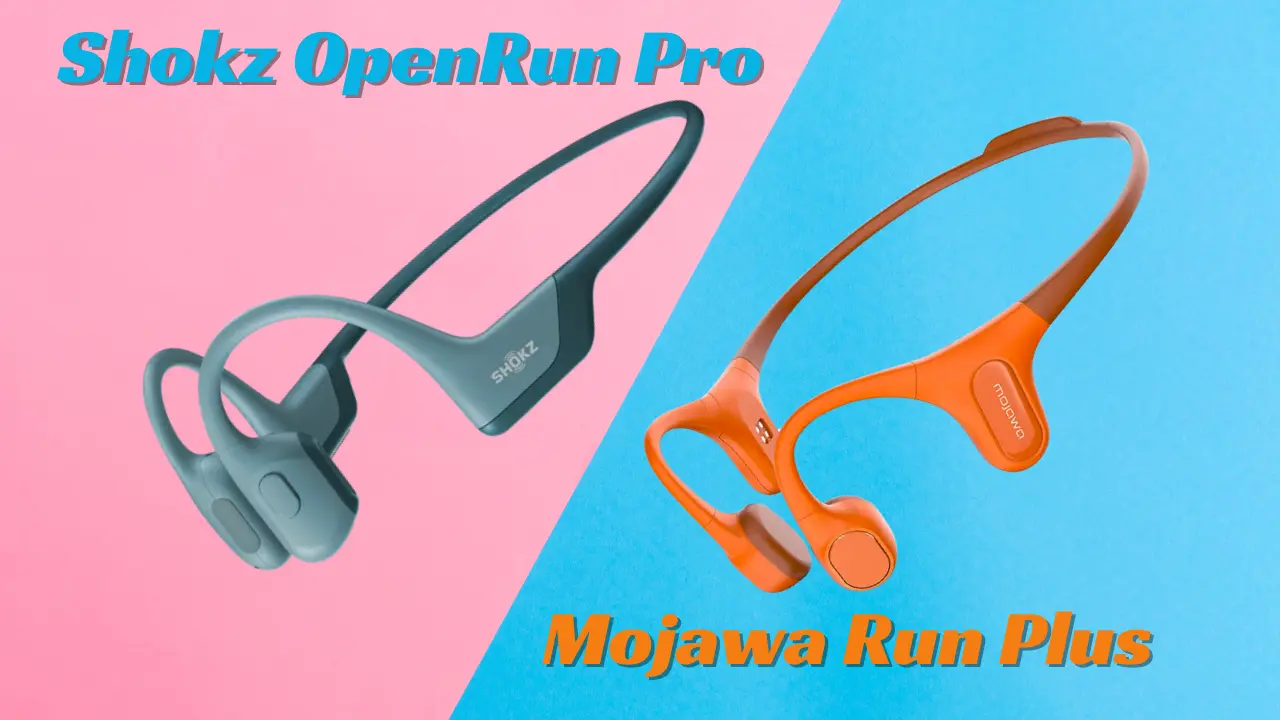Shokz has been the reigning name in bone conduction headphones for many years. That’s well-deserved since Shokz pioneered commercial bone conduction technology with many high-quality products. However, many competitors have emerged to give Shokz a run for its money, and the Mojawa Run Plus is a worthy competitor.
So, which is the better option? Is it best to stick with the well-known Shokz OpenRun Pro, or is it worth forking out your hard-earned dollars for the newcomer, the Mojawa Run Plus? I’ve been using the OpenRun Pro for a long time and recently had the opportunity to test the Run Plus. Here are my thoughts about both so you can make an informed decision.

Verdict
The Mojawa Run Plus’ sound quality is comparable to that of the OpenRun Pro, but the feature that makes it stand out most is its built-in MP3 player, which the OpenRun Pro lacks. It also has better water resistance, but the OpenRun Pro has a longer battery life and is slightly more comfortable.
The Mojawa Run Plus is ideal for people like triathlon athletes and swimmers, though runners and cyclists can also use it. The OpenRun Pro’s longer battery life and more comfortable fit make it the better option for prolonged use.
Technology and Unique Features
The Shokz OpenRun Pro and Mojawa Run Plus are bone conduction headphones with open-ear designs. This means that no sound passes through your outer ears. Instead, both headphones vibrate against your skull to send sound directly to your inner ears, making them ideal for athletes because they allow for excellent environmental awareness.
Mojawa beats the OpenRun Pro in water resistance. The Run Plus has an IP68 rating, which means it’s safe to use while swimming. The OpenRun Pro’s rating is only IP55, so it’s good against sweat and rain but not swimming.
That brings me to the Run Plus’ most significant advantage: it has a built-in MP3 player, which the OpenRun Pro lacks. This is essential because Bluetooth signals don’t travel well in water, so swimmers can’t use regular Bluetooth headphones in the pool. Shokz has a separate model, the OpenSwim, with an MP3 player, but Mojawa managed to fit both functions into one device.
Design, Build Quality, and Comfort
The two devices are very similar in design and appearance. Both feel like sturdy, well-made products, so there’s no problem in that department.
They are also similar in terms of fit and comfort. They fit comfortably, even while wearing glasses, though I found them to be slightly less comfortable with glasses that have thicker frames. They are still not uncomfortable, though. The two models’ weights are identical at 29g, so that won’t make any difference to their comfort.
The one significant difference is that the Mojawa is tighter than the OpenRun Pro. This is great initially because the added pressure makes it feel sturdier. However, the pressure can become too much after a while. In this case, the OpenRun Pro is definitely the better option for prolonged use cases.
Sound Quality
Bone conduction headphones aren’t famous for their sound quality. You naturally sacrifice some quality and volume for the benefit of environmental awareness.
However, these devices both have very good sound quality for bone conduction headphones. As the pioneer of commercial bone conduction headphones, Shokz has made incredible strides over the last few years in improving the sound quality and volume on its devices, and the OpenRun Pro is surprisingly good, though slightly lacking in bass.
I would say the Mojawa Run Plus is just as good as the OpenRun Pro, except for their bass performance. It has four equalizer presets: Balanced, Bass Boost, Vocal, and Swim. The Bass Boost preset does a fantastic job. Though it doesn’t deliver hard thumping bass, it’s much more prominent than with the OpenRun Pro.
On the downside, I could feel the Mojawa vibrating quite intensely against my skin when listening to songs with powerful bass. This might be irritating to some users.
Volume Levels
Volume is always a problem with bone conduction headphones, mainly because they don’t isolate our ears from outside noise.
With that fact in mind, Mojawa’s top volume is quite good. They are perfectly usable while running or cycling on busy roads, and I could even hear podcasts clearly when the traffic was quite heavy.
Unfortunately, this is where the OpenRun Pro fails to deliver since its top volume is pretty low. It’s good enough for general use in the gym or during early morning runs, for example, but it can be difficult to hear when the traffic gets heavy.
Control
Both devices’ controls are easy to use and quite intuitive, though they differ considerably.
The Shokz has a Power / Volume Up button, a Volume Down button, and a Multifunction button, which you can use for various purposes like playing, pausing, skipping tracks, taking calls, or using the voice assistant. They work well, though some people find physical buttons a pain to work with while running.
The Mojawa is a bit different. It has two buttons located on the vibrating transducers. You use these buttons for power, playing, pausing, and skipping tracks. But it also has touch-sensitive pads situated just behind the earpieces. You simply swipe your fingers over them to control the volume.
This touch control is very convenient when running since you don’t have to fidget with buttons. However, when the device or your hands are wet (like when you’re swimming), they become more challenging to use.
Battery Life and Charging
The Mojawa Run Plus offers eight hours of battery life at 75% volume (it’s important to note that battery life is reduced to two hours when the headphones are submerged). The headphones come with a magnetic charging cable that ensures a solid connection. Fast charging gives you an hour and a half of listening time after just five minutes of charging, and it charges to 100% in 50 minutes.
The Shokz OpenRun Pro offers up to ten hours of listening time at moderate volume levels, reduced to four hours at maximum volume. It also supports fast charging through its magnetic charging cable. Like the Mojawa, charging it for five minutes will give you an hour and a half of listening time. Charging it to 100% takes about an hour.
In summary, Mojawa’s battery life is shorter than the OpenRun Pro’s, but charging to 100% is a bit faster.
Price and Value for Money
The OpenRun Pro is a good and reliable product at a decent price. Despite its few flaws, it’s a good product that works as intended, and Shokz’s brand reputation makes it worth the price, especially with its longer battery life and more comfortable fit over long periods.
The Mojawa Run Plus is a surprising offering. Its built-in MP3 player, higher water resistance, stronger bass, and better volume make it a worthy competitor, especially considering that it costs quite a bit less than the OpenRun Pro. Regarding general value for money, the Mojawa is a clear winner.
Conclusion
Both devices are excellent bone conduction headphones, but they cater to different users.
Without a doubt, the Mojawa Run Plus is great for all athletes or anyone who’s passionate about sports and fitness, especially those who swim or exercise in wet conditions. The built-in MP3 player is also great for people who don’t like to take their phones with them while running. However, it’s not necessarily ideal for marathon runners since the headphones can get uncomfortable after a while.
Anyone who won’t be swimming, won’t need very high volumes and bass, or plans to wear the headphones for extended periods will probably prefer the Shokz OpenRun Pro. It has limitations, and you will have to keep your phone or smartwatch with you if you want to listen to music or podcasts, but it’s still a good, reliable offering at a decent price.



